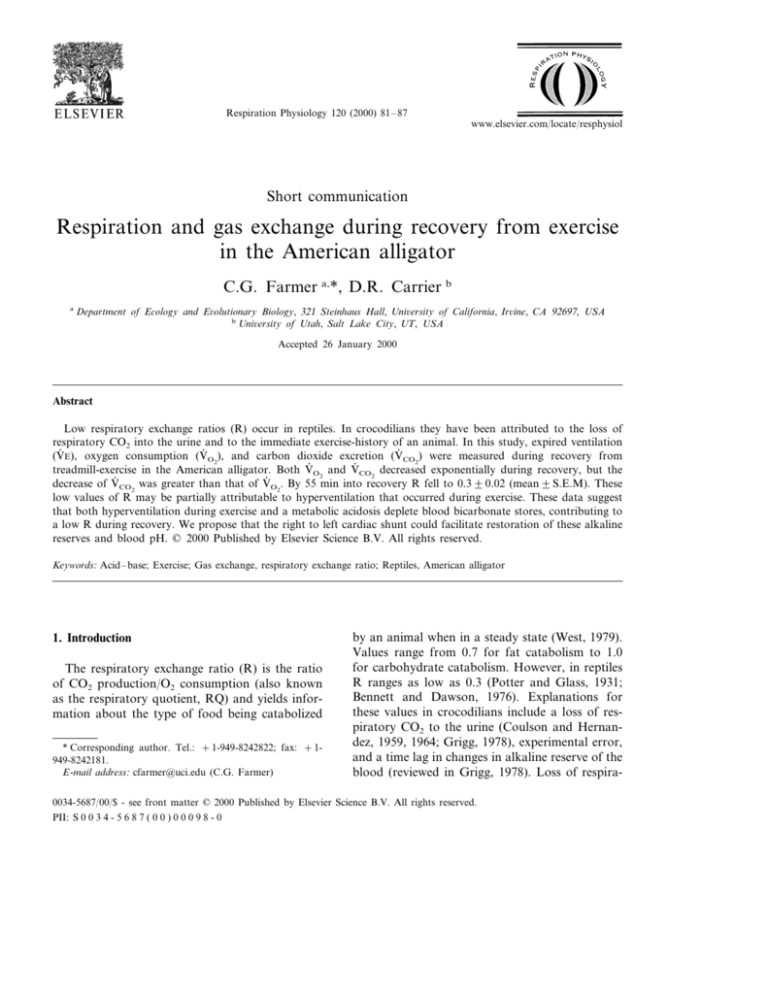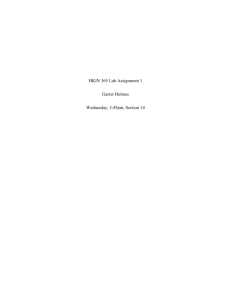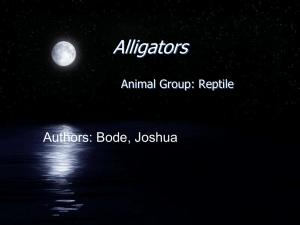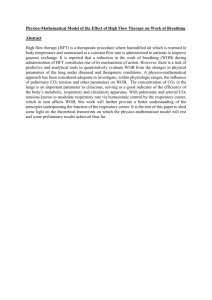
Respiration Physiology 120 (2000) 81 – 87
www.elsevier.com/locate/resphysiol
Short communication
Respiration and gas exchange during recovery from exercise
in the American alligator
C.G. Farmer a,*, D.R. Carrier b
a
Department of Ecology and E6olutionary Biology, 321 Steinhaus Hall, Uni6ersity of California, Ir6ine, CA 92697, USA
b
Uni6ersity of Utah, Salt Lake City, UT, USA
Accepted 26 January 2000
Abstract
Low respiratory exchange ratios (R) occur in reptiles. In crocodilians they have been attributed to the loss of
respiratory CO2 into the urine and to the immediate exercise-history of an animal. In this study, expired ventilation
(V: E), oxygen consumption (V: O2), and carbon dioxide excretion (V: CO2) were measured during recovery from
treadmill-exercise in the American alligator. Both V: O2 and V: CO2 decreased exponentially during recovery, but the
decrease of V: CO2 was greater than that of V: O2. By 55 min into recovery R fell to 0.39 0.02 (mean9 S.E.M). These
low values of R may be partially attributable to hyperventilation that occurred during exercise. These data suggest
that both hyperventilation during exercise and a metabolic acidosis deplete blood bicarbonate stores, contributing to
a low R during recovery. We propose that the right to left cardiac shunt could facilitate restoration of these alkaline
reserves and blood pH. © 2000 Published by Elsevier Science B.V. All rights reserved.
Keywords: Acid – base; Exercise; Gas exchange, respiratory exchange ratio; Reptiles, American alligator
1. Introduction
The respiratory exchange ratio (R) is the ratio
of CO2 production/O2 consumption (also known
as the respiratory quotient, RQ) and yields information about the type of food being catabolized
* Corresponding author. Tel.: +1-949-8242822; fax: +1949-8242181.
E-mail address: cfarmer@uci.edu (C.G. Farmer)
by an animal when in a steady state (West, 1979).
Values range from 0.7 for fat catabolism to 1.0
for carbohydrate catabolism. However, in reptiles
R ranges as low as 0.3 (Potter and Glass, 1931;
Bennett and Dawson, 1976). Explanations for
these values in crocodilians include a loss of respiratory CO2 to the urine (Coulson and Hernandez, 1959, 1964; Grigg, 1978), experimental error,
and a time lag in changes in alkaline reserve of the
blood (reviewed in Grigg, 1978). Loss of respira-
0034-5687/00/$ - see front matter © 2000 Published by Elsevier Science B.V. All rights reserved.
PII: S 0 0 3 4 - 5 6 8 7 ( 0 0 ) 0 0 0 9 8 - 0
82
C.G. Farmer, D.R. Carrier / Respiration Physiology 120 (2000) 81–87
tory CO2 to urine appears not to explain the low
values found in crocodilians (Grigg, 1978; Coulson and Hernandez, 1983). Experimental error
also seems an unlikely explanation. Hence, a time
lag in alkaline changes in the blood is probably a
source of the variability of R.
If an animal increases ventilation such that
alveolar (or faveolar) PCO2 declines below normal
resting values (hyperventilation), it may take some
time for alveolar PCO2 and PO2 to regain steady
state because of CO2 and O2 stores in the body
(West, 1979). Because CO2 is stored in plasma
and in the interstitial fluids as bicarbonate, it
takes much longer for CO2 than for O2 to reach
equilibrium (West, 1979). Initially with the onset
of hyperventilation, R in the expired gas is elevated as the CO2 stores are washed out of the
body; the opposite occurs with the onset of hypoventilation (West, 1979). Low Rs reported for
alligators have been associated with recovery from
struggling (Hicks and White, 1992). More recently, we observed severe hyperventilation during
treadmill-locomotion in alligators which could
contribute to a time lag in alkaline reserves of the
blood during recovery from exercise (Farmer and
Carrier, 2000). Although we do not understand
the reason for this hyperventilation, it is known
that crocodilians have an unusually large pulmonary air-to-blood barrier thickness (Perry,
1993). It is possible that hyperventilation is necessary to maintain arterial saturation. We undertook this study to examine changes in respiratory
and gas exchange parameters during recovery
from exercise to determine how R varied.
2. Materials and methods
2.2. Training
Animals were trained to walk on a treadmill
over the course of several months. By exposing
them to short training sessions (several min of
walking with 10 min intervals for rest) two to
three times a week, the endurance of the animals
improved until they could sustain repeated bouts
of 4 min of continuous walking interspersed with
25 min of rest.
2.3. Ventilation and gas exchange
To measure ventilation and gas exchange, a
mask was constructed out of the tip of a 30 ml
plastic syringe. Two ports were drilled into the
syringe and flexible, Hytrel® tubing (Hans
Rudolph, Inc., Kansas City, MO) with an inside
diameter of 9 mm was glued to the ports. Flow
control units (Ametek, Pittsburgh, PA) were used
to pull fresh air (FIO2 = 0.2093 and FICO2 =
0.0003) through the mask at an approximate rate
of 5.4 L/min. This was the biased flow determined
to eliminate rebreathing by the alligators during
their most vigorous exercise. A pneumotach
(Hans Rudolph, Inc., Kansas City, MO) was
placed in the line upstream from the mask; a
portion of the gas flowing through the mask was
diverted and pulled through Drierite (anhydrous
calcium sulfate) and then through oxygen (Beckman OM-11, Fullerton, CA) and carbon dioxide
(Ametek CD-3A, Pittsburgh, PA) analyzers. The
mask was sealed with epoxy over the nares. The
mouth of the animal was sealed with duct tape to
ensure all respiratory gases were collected. The
ventilation and gas exchange system was calibrated by injecting known volumes of gas into the
mask before it was attached to the animal.
2.1. Animals
2.4. Data collection and analysis
Five captive raised American alligators (Alligator mississippiensis) were kept in aquaria with
basking platforms and both heat and full spectrum light sources. They experienced a photoperiod of 14:10 h light:dark. They were fed a diet of
goldfish, smelts, mice, rats, and eggs. The animals’
weight ranged from 1.18 to 1.66 kg; the mean
weight was 1.34 kg.
Signals from the gas analyzers and the differential pressure transducer of the pneumotach were
converted to digital form using an AD converter
(Biopac System, Goleta, CA) and stored on a
Macintosh computer. Signals were sampled at a
rate of 50 Hz and analyzed with Acqknowledge
software (Biopac System Goleta, CA).
C.G. Farmer, D.R. Carrier / Respiration Physiology 120 (2000) 81–87
83
Respiration is reported at body temperature,
ambient pressure, and saturated with water vapor
(BTPS). Gas exchange is expressed at standard
temperature and pressure, dry (STPD) (West, 1979).
Values are means and standard error about the mean
(mean9 S.E.M.). Pre-exercise values for expired
ventilation (V: E), tidal volumes (V: T), respiratory
frequency (fR), oxygen consumption (V: O2), and
carbon dioxide excretion (V: CO2) were obtained
several hours after the animal had been instrumented. Exercise values of V: O2, V: CO2, V: E, fR, and
VT were collected during the last min of a 4-min
exercise bout at 0.44 m/sec. Recovery values are an
average of one min of data for the following periods:
1, 5, and 15 min after cessation of exercise. Three
min of data were averaged for: 25 – 28 min and 55 – 58
min of recovery. It was necessary to increase the
period examined during the latter part of recovery
due to a low respiratory frequency. These values
were used to compute respiratory gas exchange
ratios (V: CO2/V: O2); air convection requirements (V: E/
V: O2 and V: E/V: CO2); extraction (V: O2/V: E*FIO2); as well
as to estimate faveolar PCO2 with the alveolar gas
equation assuming a dead space volume of 4.2 ml/kg
(Hicks and White, 1992). Paired t-tests were use to
determine statistically significant (P B 0.05) differences.
no less than 25 min of rest, an exercise trial was
repeated at a higher speed. This procedure was
repeated until the animals had walked at 0.17, 0.31,
and 0.44 m/sec, which was the highest speed for
which we were able to get sustained locomotion.
Hence we were able to collect 1 min of data after
the walking alligators had reached steady state,
which occurred within 1.5–2 min after the start of
exercise. At the end of the exercise period at the
highest speed studied, the animals were left undisturbed on the treadmill while recovery was monitored for 1 h.
The second reason for this protocol is that
recovery from an intense, anaerobic burst of struggling has been studied previously (Coulson and
Hernandez, 1964, 1980, 1983). We were interested
in recovery from exercise in which the animal was
unencumbered from breathing freely, either during
or after the exercise period. Hence we avoided
intense exercise where excessive handling could
suppress ventilation. We also avoided exercise in
water for the same reason. Because we wanted the
animals to work at a pace that was sustainable for
at least 4 min but we wanted the most intense exercise
possible within these parameters, we used repeated
bouts of exercise at progressively higher speeds.
2.5. Experimental protocol
3. Results
All animals had fasted for at least 4 days before
the experiments. They were brought from the animal
care facility to the experimental chamber the night
before data were collected. The experimental chamber was kept at 30°C.
Our protocol was determined by two factors.
First, as part of a previous study, we were interested
in collecting data of gas exchange and ventilation
during exercise on alligators in a steady state
(Farmer and Carrier, 2000). The focus of this study
was to determine whether or not alligators experienced a mechanical constraint on simultaneous
running and breathing. To assess this, we allowed
an animal several hours on the treadmill after
instrumenting to calm down from the handling and
masking before pre-exercise data were collected.
After monitoring pre-exercise, the treadmill was
started and the animal exercised for 4 min. After
During exercise all animals hyperventilated
severely (Fig. 1). Expired ventilation declined immediately during the min following exercise by 73%.
This was due to a large decrease in respiratory
frequency and a smaller drop in tidal volume (Fig.
1). By 25 min of the recovery period, ventilation had
decreased to pre-exercise values. The equation that
best describes the ventilation during and after
exercise is given in Table 1.
Table 1
Equations fit to expired ventilation and gas exchange during
and after treadmill-locomotion
Equation
r2
V: E =−248.48 log(t)+414.8
V: CO2 =11.615×10(−0.027t)
V: O2 =8.469×10(−0.017t)
0.988
0.951
0.869
84
C.G. Farmer, D.R. Carrier / Respiration Physiology 120 (2000) 81–87
Oxygen consumption and carbon dioxide excretion declined upon the cessation of exercise (Fig.
1), however the rate of decrease was faster for
V: CO2 than for V: O2. This point is illustrated by the
equations that describe the rates of decline (Table
1). V: O2 during the first minute of recovery was not
significantly different from exercise (PB0.05).
VO2 was significantly different from exercise by
Fig. 1. Mean (n =5) and standard errors for oxygen consumption (V: O2), carbon dioxide excretion (V: CO2), expired ventilation (V: E),
tidal volume (VT), and respiratory frequency (fR) before exercise, during the last minute of exercise, and during recovery. Recovery
begins at t=0. If error bars are not seen it is because they are contained within the symbols. Symbols are as follows: solid
square = pre-exercise, solid circle = exercise, open circle =recovery, * indicates a value that is not statistically different from
pre-exercise (i.e. P \0.05 paired t-test).
C.G. Farmer, D.R. Carrier / Respiration Physiology 120 (2000) 81–87
85
Fig. 2. Mean (n = 5) and standard errors for air convection requirements (V: E/V: O2 and V: E/V: CO2), extraction, respiratory exchange
ratio (R), and estimates of lung PCO2 (PACO2) before exercise, during the last minute of exercise, and during recovery. Recovery
begins at t=0. If error bars are not seen it is because they are contained within the symbols. Symbols are as follows: solid square,
pre-exercise; solid circle, exercise; open circle, recovery, * indicates a value that is not statistically different from pre-exercise (i.e.
P \ 0.05 paired t-test).
min five (P B 0.05). In contrast, V: CO2 was significantly different from the exercise value during the
first minute of recovery (P B 0.05).
Respiratory gas exchange ratios declined significantly (PB 0.05) from exercise levels during the
first minute of recovery. Then they rebounded to
exercise levels by 5 min into recovery, after which
they continued to decline. However, they remained above pre-exercise values until 25 min
(Fig. 2). They were significantly lower than pre-
86
C.G. Farmer, D.R. Carrier / Respiration Physiology 120 (2000) 81–87
exercise values by 55 min of recovery, reaching
0.3 90.02 (mean9S.E.M) (Fig. 2).
The changes in air convection requirements
with cessation of exercise were different for O2
than for CO2. V: E/V: CO2 declined immediately during the first min of recovery to a mean value that
was significantly less than pre-exercise and remained so throughout 5 min of recovery (P B
0.05). In contrast, although there was a large
decline in V: E/V: O2 during the first minute of recovery, V: E/V: O2 did not drop below pre-exercise levels. Air convection requirements for oxygen were
not significantly different from pre-exercise values
for the first, fifteenth, and twenty-fifth minute of
recovery (Fig. 2). At 5 and 55 min and of recovery, V: E/V: O2 was significantly less (P B0.05) than
during pre-exercise (Fig. 2).
During recovery, O2 extraction immediately increased from exercise values and remained elevated during the 60 min period (Fig. 2) By 15 min
of recovery extraction was not significantly different from pre-exercise values (P \0.05). By 55 min
of recovery extraction had increased to approximately 40%, significantly elevated above pre-exercise levels (PB0.05).
Estimates of lung PCO2 obtained with the alveolar gas equation immediately increased with the
cessation of exercise (Fig. 2). The values were not
significantly different from pre-exercise values
throughout the recovery period (Fig. 2).
4. Discussion
Our analysis of ventilation and respiratory gas
exchange during and after exercise indicates
highly variable gas exchange ratios. Under the
conditions of this study, R varied from a normal
range (between 0.7 and 1.0) before exercise, to 1.4
during exercise and at 5 min after exercise, to 0.3
by 55 min of recovery. We suspect that both
hyperventilation and a metabolic acidosis contribute to this pattern of gas exchange. R can be
greatly elevated simply by hyperventilation and
both the ventilatory equivalents and the estimate
of lung PCO2 indicate a severe hyperventilation
occurred during exercise. However, if an elevated
R were caused by hyperventilation alone, a rapid
return to pre-exercise levels, or below pre-exercise
levels, is expected when the hyperventilation
ceases. Although R significantly declined for the
first minute of recovery, it did not drop below 1 in
spite of the return to pre-exercise lung PCO2. We
suggest this elevation in R, that remained until 25
min of recovery, is due to a metabolic acid load
incurred during exercise. Hence, repeated bouts of
treadmill-exercise that were sustainable for 4 min
in alligators appear to cause both a metabolic acid
load and a respiratory alkalosis. Both of these
factors can deplete blood bicarbonate stores. It
has long been known that one way to restore
blood bicarbonate is to hypoventilate so that CO2
is retained. However unlike mammals, crocodilians have another way to restore blood bicarbonate and pH. They can shunt blood around the
lungs (a right to left shunt).
The right to left shunt has long been suggested
to be important for diving ectothermic tetrapods
in facilitating oxygen uptake from the lungs as the
dive progresses (White, 1978, 1985; Grigg, 1992).
By sequestering CO2 in the tissues and away from
the lungs, a right to left shunt may aid the continued uptake of pulmonary oxygen in spite of a
declining Alveolar-arterial O2 gradient by decreasing the rate at which P50 in the lung increases
(White, 1978; Grigg, 1992). Furthermore, a build
up of CO2 in the tissues would facilitate oxygen
unloading there, due to the Bohr effect. Previous
studies have found mixed results regarding
whether or not the right to left shunt occurs
during forced diving (White, 1969; Jones and
Shelton, 1993).
Recovery from treadmill-exercise is not
analogous to forced diving because the alligators
were free to breathe whenever they desired
thereby replenishing lung O2 stores. However, as
with diving animals, a right to left shunt would
divert CO2 rich blood away from the lung and
might facilitate the retention of CO2 during recovery. This could help reestablish blood bicarbonate
buffer stores and restore blood pH, while still
enabling oxygen uptake in the lungs. Such a
blood flow pattern may partially explain the extremely low respiratory gas exchange value (0.3)
and the large extraction (40%) found at 55 min of
recovery. Hence these respiratory data raise some
C.G. Farmer, D.R. Carrier / Respiration Physiology 120 (2000) 81–87
provocative questions regarding potential cardiovascular patterns that may be present during and
after exercise. Because anesthesia and catheterization can induce hyperventilation and alter blood
gas and bicarbonate parameters (Forster and Pan,
1988), we undertook this study to characterize the
respiratory parameters in animals that have not
undergone these procedures. However, preliminary data indicate that alligators develop a right
to left shunt after treadmill-exercise (C.G.
Farmer, L. Hartzler, and J.W. Hicks,
unpublished).
Acknowledgements
We are indebted to J.W. Hicks for many insights, for helpful comments on the manuscript,
and for the use of equipment. We are grateful to
J.W. Hicks, K. Packard, G. Packard, and to the
Florida Freshwater Fish and Game Commission
for supplying us with alligators. We thank Jon
Tlachac for his assistance with training the animals. This study was funded by NIH c1F32HL09796-01 to C.G. Farmer and NSF
IBN-9807534 to D.R. Carrier.
References
Bennett, A.F., Dawson, W.R., 1976. Metabolism. In: Gans,
C., Dawson, W.R. (Eds.), Biology of the Reptilia. Academic Press, New York, NY, pp. 127–223.
Coulson, R.A., Hernandez, T., 1959. Source and function of
urinary ammonia in the alligator. Am. J. Physiol. 197,
873 – 879.
Coulson, R.A., Hernandez, T., 1964. Biochemistry of the
Alligator: A Study of Metabolism in Slow Motion. Lousiana State University Press, Baton Rouge, LA.
87
Coulson, R.A., Hernandez, T., 1980. Oxygen debt in reptiles:
relationship between the time required for repayment and
metabolic rate. Comp. Biochem. Physiol. 65A, 453 – 457.
Coulson, R.A., Hernandez, T., 1983. Alligator Metabolism:
Studies on Chemical Reactions in Vivo. Pergamon Press,
Oxford.
Farmer, C.G., Carrier, D.R., 2000. Ventilation and gas exchange during treadmill-locomotion in the American Alligator (Alligator mississippiensis). J. Exp. Biol. (in press).
Forster, H.V., Pan, L.G., 1988. Breathing during exercise:
demands, regulation, limitations. In: Gonzalez, N.C.,
Fedde, M.R. (Eds.), Oxygen Transfer From Atmosphere to
Tissues. Plenum Press, New York, NY, pp. 257 – 276.
Grigg, G.C., 1978. Metabolic rate, Q10 and respiratory quotient (RQ) in Crocodylus porosus, and some generalizations
about low RQ in reptiles. Physiol. Zool. 51, 354 – 360.
Grigg, G., 1992. Central cardiovascular anatomy and function
in crocodilia. In: Wood, S.C., Weber, R.E., Hargens, A.R.,
Millard, R.W. (Eds.), Physiological Adaptations in Vertebrates, Respiration, Circulation and Metabolism. Marcel
Dekker, New York, NY, pp. 339 – 353.
Hicks, J.W., White, F.N., 1992. Pulmonary gas exchange
during intermittent ventilation in the American alligator.
Respir. Physiol. 88, 23 – 36.
Jones, D.R., Shelton, G., 1993. The physiology of the alligator
heart: left aortic flow patterns and right to left shunts. J.
Exp. Biol. 176, 247 – 269.
Perry, S.F., 1993. Evolution of the lung and its diffusion
capacity. In: Bicudo, J.E.P.W. (Ed.), The Vertebrate Cascade: Adaptations to Environment and Mode of Life.
CRC Press, Boca Raton, pp. 142 – 153.
Potter, G.E., Glass, H.B., 1931. A study of respiration in
hibernating horned lizards, Phrynosoma cornutum. Copeia
1931, 128 – 131.
West, J.B., 1979. Respiratory physiology — the essentials.
Williams and Wilkins, Baltimore, MD.
White, F.N., 1969. Redistribution of cardiac output in the
diving alligator. Copeia 3, 567 – 570.
White, F.N., 1978. Circulation: a comparison of reptiles,
mammals, and birds. In: Piiper, J. (Ed.), Respiratory Function in Birds, Adult and Embryonic. Springer-Verlag,
Berlin, pp. 51 – 60.
White, F.N., 1985. Role of intracardiac shunts in pulmonary
gas exchange in chelonian reptiles. In: Johansen, K.,
Burggren, W. (Eds.), Cardiovascular Shunts: Phylogenetic,
Ontogenetic and Clinical Aspects. Munksgaard, Copenhagen, pp. 296 – 309.
.
All in-text references underlined in blue are linked to publications on ResearchGate, letting you access and read them immediately.








